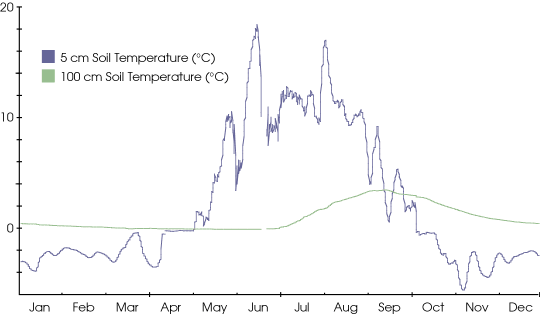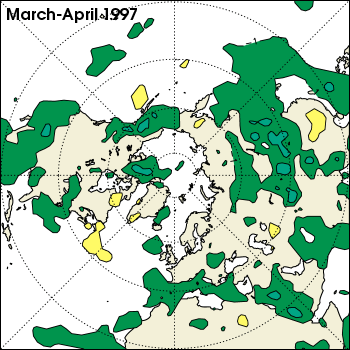

| Improving the Forecast Models |
| ||
 In order to construct
accurate computer models of the boreal ecosystem, the BOREAS team must
take many variables into account. One problem the scientists face is
predicting soil temperatures and knowing when the soils thaw. Soil
dynamics are not easy to track from year-to-year because there are thick
layers of moss that insulate much of forest floor. Current models
don’t accurately represent the role moss plays in the hydrological
(water) cycle in the boreal ecosystem. In order to construct
accurate computer models of the boreal ecosystem, the BOREAS team must
take many variables into account. One problem the scientists face is
predicting soil temperatures and knowing when the soils thaw. Soil
dynamics are not easy to track from year-to-year because there are thick
layers of moss that insulate much of forest floor. Current models
don’t accurately represent the role moss plays in the hydrological
(water) cycle in the boreal ecosystem.
Moss helps keep the deeper layers of soil frozen, as well as the roots of trees, well into the spring, thereby reducing water vapor. When it rains in the summer, the moss acts like a sponge and soaks up a lot of the water. About one-third of the total amount of water that is evaporated by the boreal ecosystem in the summer comes from moss within a few days after a rain. |
Moss covers the ground throughout the boreal forest, including the upland black spruce study area shown here. The moss inhibits water evaporation, helping keep the soil wet and the atmosphere dry and sometimes covering pools of standing water. (Photograph courtesy BOREAS project) | ||
 | |||
| BOREAS measurements show that in the spring and summer, only about
one-third of the solar radiation absorbed by the boreal ecosystem is
used in evaporation, while about two-thirds is emitted as heat. But the
ECMWF model computed that half of the radiation is used in evaporation
and half is emitted as heat. The NCEP model computed that 70 percent of
the solar radiation is used in evaporation and only 30 percent is
emitted as heat. Consequently, these models were predicting more
precipitation—as much as 50 percent more—than was actually
being measured (Betts et al. 1998).
By introducing their new BOREAS data into the weather models, Betts
says he expects to see significant improvements in forecasts of daily
temperature, cloud cover and precipitation amounts. It typically takes
a few years to develop and test these forecast model changes, Betts
explains. When the changes that are being tested this summer are
complete, he plans to go back and re-analyze both the old forecasts, the
new forecasts, and the actual measurements to get a quantitative measure
of how much the models have improved. He won’t get the results of
those analyses until the year 2000, but loftier goals await over the
horizon. |
This graph shows soil temperatures at 5 and 100 centimeters during 1995. The upper soil is insulated by snow in the winter, but warms quickly in summer. (Note: snowmelt is shown by the constant zero degree temperature during April.) In contrast, the deep soils remain near freezing through early summer, not warming up until the air temperature has already begun to drop. This prevents the trees from evaporating water at their full capacity. (Graph by Robert Simmon, based on data from Sutton, Doug, Mike Goulden, and Steven Wofsy. 1998. BOREAS TF-03 NSA-OBS Tower Flux, Meteorological, and Soil Temperature Data. Available online from the ORNL Distributed Active Archive Center, Oak Ridge National Laboratory, Oak Ridge, Tennessee, U.S.A.) | ||
 "Today, global forecast models are evolving into Earth system models," Betts states. "New land measurements are improving land surface meteorological forecasts significantly, so that there will be another round of improvements to the models in 2001. Then, we will enter our revised understanding of the global carbon cycle into the Earth system models. Over the next 5-10 years, global forecast models will become fairly complete Earth system models." |
This map shows the average errors in the improved European Centre for Medium-Range Weather Forecasts at 850mb (roughly equivalent to an altitude of 1500m) for March and April of 1997. The model used in 1997 used a reduction in the forest snow albedo based on BOREAS data to improve the 5-day forecasts. (Figure from Viterbo, P. and A.K. Betts, 1999: The impact on ECMWF forecasts of changes to the albedo of the boreal forests in the presence of snow. J. Geophys. Res. (In press, BOREAS special issue). Courtesy A.K. Betts)
| ||